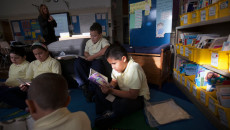LatinaLista — When it comes to transracial adopting — when an adopted child is of a different race/ethnicity from the adoptive parents — a loving home outweighs any other concern for what is best for the child. Yet, it makes sense that, if possible, a child should be placed with a family that shares a common cultural or racial background.
It’s not happening in some cases.
In 2008, 21.5 percent of adopted children were of a different race than their adoptive parent. According to the 2011 Adoption and Foster Care Analysis and Reporting System’s (AFCARS) report, the three largest groups of children waiting to be adopted were: White (39 percent); Black (29 percent); and Latino (22 percent).
Though minority children comprise over 50 percent of children waiting for adoption, there seems to be more white parents deemed qualified to take on the responsibility of adopting a child.
A special report focused on adoption which was published as part of America’s Children: Key National Indicators of Well-Being, 2011 revealed:
… adoptive parents were more likely than all adults to be White, non-Hispanic. Overall, 73 percent of adoptive parents were White, compared with 67 percent among all adults.
By adoption type, White, non-Hispanic parents made up 63 percent of those who adopted from foster care, 71 percent of those who adopted privately within the U.S., and 92 percent of those who adopted internationally.
There have been many anecdotal reasons offered as to why there are not more adoptive parents of color — income, lack of cultural understanding among social workers interviewing adoptive parents, unfamiliarity with the adoption process, etc.
Yet, one adoption agency is creating its own way of matching parents of color with children who share the same racial or cultural background — with help from the birth mother.
Lifetime Adoption Agency maintains an active online list of birth mothers seeking specific adoptive parents. The list features Black, Latina and Native American birth mothers who specify whether or not they want to see their children go to homes of Black, Interracial, Latino or Native American adoptive parents.
From the list, prospective parents can see the age the birth mother, the child’s age or the due date of the birth, the child’s cultural/racial background, health history and any additional special wishes of the adoptive parents from the birth mother regarding religion, marital status and contact after adoption.
It’s one way to help birth mothers make an already hard decision a little easier by ensuring that their child will always feel like they belong in their new family. Yet, there are still only two sure factors that make any transracial adoption a success.
-Dave Thomas, founder of the Wendy’s hamburger chain and creator of the Dave Thomas Foundation for Adoption






Comment(1)
Michelle Robledo
This is amazing to me, although as a Latina birthmother, I feel that the option of adoption should be talked about more within our culture. When I was a single mother of a 1 year old who found herself pregnant again, I told a coworker I wanted to place my child and was told “We Latinos don’t do that.” I was appalled, What exactly are WE supposed to do? Live on welfare and food stamps and Section 8? Should we reduce the quality of life for our minority children because our culture says to suck it up and “keep them”, even if we have no resources to care for them? I chose to place my child with an amazing family and give her a life I wouldn’t have been able to give her, as well as my son, had I kept her. I chose to provide both of my children with love an attention and opportunities they wouldn’t have otherwise had had I not placed her. Please get the word out there to Latinas and other minorities that it is up to stop the cycle of “sucking it up” and give our children the opportunities they deserve to have lives we are in no position to give them.